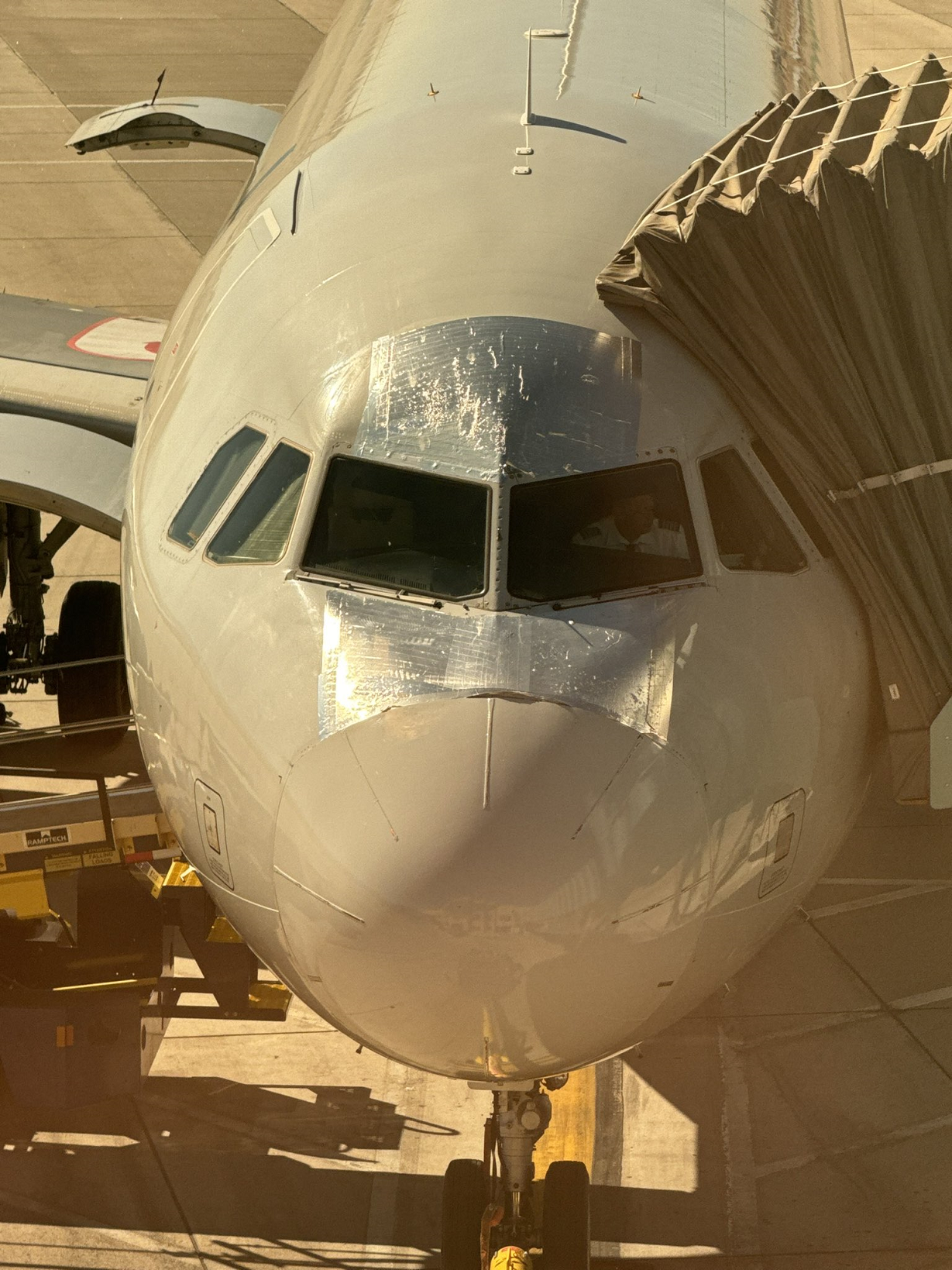Probably the most misunderstood thing in all of aviation is speed tape. Passengers see what looks like ‘duct tape’ on their plane, and they worry whether it will hold together. The plane doesn’t look safe and first impressions over safety matter right now with aviation safety top of mind given the issues we’ve seen with the Boeing 737 MAX 9 door plug, air traffic control mishaps, and pilot error over the past couple of years.
Photos like this one represent nervous passengers, and airlines making a poor impression, even though safety hasn’t been compromised. For 100 years aviation safety has been both a practice of continuous improvement, driving down risk, and of managing perceptions.
So @AmericanAir took this plane out of service last night for maintenance in CLT and canceled the flight to RSW after waiting almost 6 hours. They rebooked many to TPA this morning (as close as we could get) and then flew us on the exact same plane anyways!!! INSANE pic.twitter.com/moLPRdUrqm
— Joe (@AggieJoe123) June 30, 2025
Bruh… @AmericanAir pic.twitter.com/5hDhyRUhzk
— Political Cow (@PoliticalCow) June 30, 2025
These sorts of images scare passengers, but this isn’t duct tape. It is actually aluminum pressure-sensitive tape that can stick to an aircraft’s fuselage or wing at high speeds.
It is used in aviation for minor, temporary repairs on aircraft. It has high resistance to weather conditions and extreme temperatures. And its use is strictly regulated. In general, it is for temporary fixes until a more permanent repair can be made, often within a few days.
The location and nature of the damage on an aircraft determines whether use of speed tape is appropriate, consistent with FAA guidelines and the aircraft manufacturer’s structural repair manual. Speed tape is not indicated where it could potentially affect the structural integrity of the aircraft (or cause an aerodynamic issue).
So you’ll generally see it used for minor, non-structural damage such as covering minor dents or scratches that don’t affect structural integrity and securing loose objects such as a panel until they can be properly fixed.
There’s nothing wrong with a plane here, in the sense that it’s perfectly airworthy. But every time passengers see something like this they’re shaken, and they worry about how well managed and maintained the airline they’re flying is.
Here’s one that looks pretty bad on the ground in Albuquerque prior to boarding. The forward fuselage is the part of the aircraft’s body where the cockpit is located. It’s the plane’s “first impression” – and this one doesn’t make a very good one.

Pressure-sensitive tape dates to the 1840s, though of course the tape used later at the dawn of aviation (masking tape) wouldn’t be used on an aircraft. Duct tape was developed during World War Two. Technology has continued to evolve, but popular understanding of it – in aviation and beyond – often lags. It wouldn’t hurt for airline employees themselves to be better educated, so that they could proactively explain it to customers.


That’s the good stuff. Ain’t cheap either.
Because why draw attention to something that doesn’t need to be drawn to? If someone has a concern, maybe they….. ASK?
And let’s not talk about “Nuclear Grade” duct tape. Which is also a thing. And also ain’t cheap.
Terrified? Really?
The only passengers who are scared of that tape are the same people who wear a mask when they’re alone in a car.
Everybody else is either amused by it or oblivious to it.
Typical of the airlines, they take the position that passengers are children, explaining nothing about how things operate. Now granted anyone can look up this information, and perhaps people are getting more proactive these days (such as in their medical treatment and its costs). But still, in a gross situation like the one in the picture it seems that some effort should be made to reassure them, perhaps even with a little humor. Surgeons have found that talking with patients one on one before operations relaxes them and leads to a lower likelihood of lawsuits (“the doctor is a person like me, and they are doing their best”), perhaps there would be a lot less stress and incidents on aircraft if passengers were similarly recognized as people who may have concerns about flying.
@Denver Refugee — A bit northeast of Denver, if you’ve ever taken the long, mostly boring drive on I-90, there’s the Minuteman Missile National Historic Site Visitor Center, near Wall, South Dakota. Personally, I’d say skip Wall Drug and the Corn Palace (tourist traps), and check out that place (and the Badlands). Of course, a little further west is Mt. Rushmore (and Crazy Horse, if they ever finish it, and Deadwood, and in Wyoming, the Devil’s Tower). I hear they may add a fifth President on there soon enough, sheesh! Ah, a good ole American road trip!
The history of duct tape is wrong. It was originally called duck tape as it was made with cotton duck, a type of cloth similar to cotton canvass but with a tighter weave. Per Wikipedia the name duck tape first appeared in the Oxford English Dictionary in 1899. Masking tape was invented in 1923 per Wikipedia, so somewhat after the dawn of aviation. A type of duck tape using cotton duck and being able to be torn by hand was developed in World War II and later variations became called duct tape after being used on ducts. Duct tape first appeared in the Oxford English Dictionary in 1965 but the usage as such started in the 1950s.
Speed tape is some nasty $hit to work with. Used regularly on military aircraft when you have a broken nut plate under a panel. Sucks trying to get it off!
Only $17,000 for a 24 pack if anyone wants to play with some at home.
@1990 — I did that Dakotas road trip a couple months ago! One of my favorite trips. Big highlight was the traffic vs the East Coast — I-90 out there is a driver’s true freedom
@jns — Very interesting TIL thanks for the education and trivia
Because the oligarchy Gary shills for prefers people to live in ignorance.
@L737 — Epic! Took me decades to make it to all 50 states. Gotta find ‘reasons’ to visit some of them. I’ll say, North Dakota has even less going on than South Dakota. I only made it to Fargo. Bah!
@1990 — You saw more of ND than me as I only made it to the Welcome to North Dakota road sign haha but still counts and was my last state to check off! I do want to visit Theodore Roosevelt Nat Park soon though
@1990 – Fargo and Bismarck have some amazing bars in their respective downtowns. Not surprising when you realize that’s just about all there is to do there half of the year…
Many people on social media are stupid.
Worked on Airplanes since for many years now. This is a approved practice. Nothing to see. Before citizens spark outrage perhaps they should educate themselves on maintenance procedures. We refer to this as “speed tape”. Many many uses. Find a screw where the nut plate is loose or defective on a plane. You put a piece over it. Minor hail damage that is waiting to be repaired but poses no threat to the structure..speed tape.
Apache helicopters operating in the desert way back generated immense static electricity when spinning. Solution was to tape the blades. Next generation coatings later on absolved the requirement to tape blades up for safe operation. Like I said many uses.
Like using a bandage to cover a human skin infection or laceration, American Airlines uses FAA-compliant aviation speed tape to cover a visible aircraft outer skin boo-boo. The ongoing culture of safety first and continuous improvement is why I choose to fly on American Airlines.
Canceled the flight for maintenance then flew us out on the same plane the next day?
Lol! Idiot! They fixed it. Your the insane one
«Because the oligarchy Gary shills for prefers people to live in ignorance.” But, wait, then why did Gary reveal this and remove the ignorance? Oh, no, speed tape is people!
@warren trout: You wrote, “Canceled the flight for maintenance, then flew us out on the same plane the next day? Lol! Idiot! They fixed it. You’re the insane one.”
If I understand correctly, your aircraft was deemed unairworthy due to a lack of proper maintenance, inoperative equipment, or discrepancies in the aircraft’s records. As a result of a safety issue, your flight was canceled. The FAA-certified Aviation Maintenance Technicians (AMTs) worked overnight to correct the deficiency on your unairworthy airliner, and the airline then placed your plane back in service. To help keep you safe while flying, Aviation Maintenance Technicians frequently repair aircraft to avoid swapping equipment. Except for the delay, what is the problem with flying on an airworthy plane?
French Junk.
Do people really think two pilots are going to take out an aircraft that’s not airworthy? But the way there are standards developed by the FAA and the airline on when a plane is or isn’t airworthy along with in general the Captain can still refuse to fly a plane he/she doesn’t consider airworthy. It’s not like Jethro looks at the plane and says “looks good to me.”
@ Drrichard: “Typical of the airlines, they take the position that passengers are children, explaining nothing about how things operate.”
US airline captain here. Your idea might make sense among this crowd (people who are into and/or follow aviation) but as they say, nobody has ever gone broke by underestimating the intelligence of the general public. Trying to explain how “things operate” often makes things worse – increasing passenger anxiety and worry – instead of minimizing it.
Every flight has road warriors (who already know about speed tape) along with nervous, once-a-year, and even first-time flyers. The latter group won’t understand the subtleties of non-structural, cosmetic temporary fixes at contract-maintenance outstations to defer permanent repairs under the authorization of the MEL per FAA guidance. That’s what you’re asking to be explained to everyone.
I cannot count the number of times I have tried to clearly, slowly, and plainly offer even the simplest information about a flight to the passengers (i.e. reason for a delay, a gate change, how to proceed to baggage claim, etc.) yet there is always a portion of the group that gets it wrong. (Me, face to face with a passenger: “When you exit the jetway, the signs say to go ‘RIGHT’ for baggage claim… but due to airport construction, you actually need to go ‘LEFT’ to get there”… Them, at the top of the jetway to the gate agent: “How do I get to baggage claim?”)
I agree with Steve’s earlier post – if you have a concern, ask. Most pilots are more than willing to discuss issues about the flight. We are on board and want to arrive safely, too, after all.
Lastly, Drrichard – if you really are a doctor: Do you explain to your patients the way every instrument, test, procedure, and process in the doctor’s office works? How the machines are calibrated, read, and maintained? How the lab results are verified and what the data looks like compared to similar populations? Or do you ask that your patients trust your expertise in managing all of those details, and assume if a patient has concerns about any of that, they can simply ask? Same thing goes for us and our profession.
What passengers are terrified?? 95% don’t even open their window shades. They are happily clueless apparently.
@George Romey — Yeah, do folks realize the pilots are onboard? Bah… unless they both have a ‘death wish’ (sheesh).
It’s not the tape on the exterior that’s concerning. It’s the tape all over the inside of the aircraft to keep things like overhead units from falling apart, also used to secure piles of baggage stored under broken seats.
Working for one of the big legacy airlines, I can tell you there is a lot going on here that passengers don’t see and don’t understand. As many have stated the use of speed tape is not about safety.
To generalize, the decision to use speed tape is often made to keep the aircraft in service until its next trip to a maintenance base. In many instances, where speed tape is required, the fix necessitates resources beyond what line maintenance or contract maintenance at an airport has available. American has a highly talented line maintenance team at many US airports – many of them working in the dead of night to perform preventative maintenance. But they don’t do sheet metal work, and they particularly don’t do composite work. Sheet metal and composite work is mostly done at maintenance bases – for American that’s Tulsa, DFW, Pittsburgh, and Charlotte with Tulsa handling the most complex issues. American’s Tulsa base has a dedicated composite shop. In other cases, parts that aren’t readily available may need to be sourced from the manufacturer or secondary sources.
The decision to fly with speed tape is not made in a bubble – the AMT on the ground consults with the Maintenance Operations Center and both ensure the fix is compliant with FAA, manufacturer, and airline specs. In addition, the PIC still has to sign-off on the airworthiness of the aircraft.
It may not look good, but it’s often a choice of speed tape or canceling a flight due to lack of another suitable aircraft.